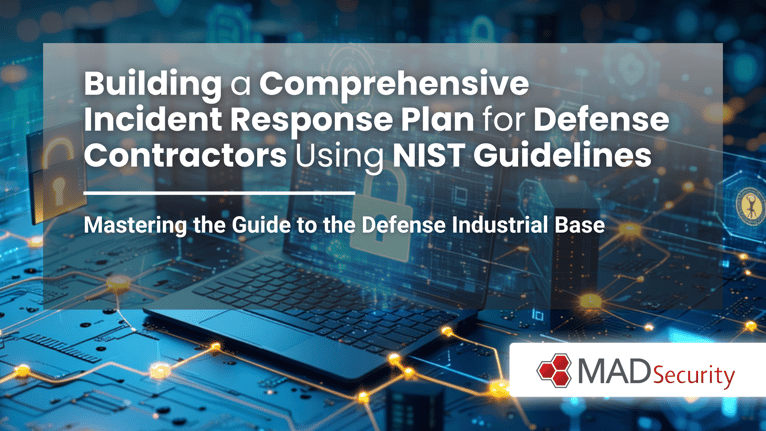
Building a NIST-Based Incident Response Plan for Defense Contractors
Incident response planning is a critical component of protecting any organization’s assets, and it is essential for defense contractors who handle sensitive information and systems. By developing a comprehensive incident response plan that follows National Institute of Standards and Technology (NIST) guidelines, you can safeguard your organization’s assets and minimize the impact of any incidents that may occur.
In this article, we will discuss the steps for building a robust incident response plan using NIST guidelines. We will also explore the benefits of using managed cybersecurity outsourcing and highlight some key considerations for defense contractors when selecting a service provider.
Why Incident Response Planning Is Crucial for Defense Contractors
As defense contractors handle sensitive information and systems, a single security incident can have a devastating impact on the organization’s operations and reputation. An incident response plan provides a structured framework for responding to security incidents promptly and effectively, minimizing the impact on the organization.

The Benefits of Managed Cybersecurity Outsourcing
One option for addressing incident response planning is to use managed cybersecurity outsourcing, where a service provider is responsible for monitoring and protecting your systems on an ongoing basis. There are several advantages to implementing incident response planning using a service provider:
1. Access to Experienced Security Professionals: A reputable managed cybersecurity service provider has a team of experienced security professionals specializing in managing and mitigating security incidents. These professionals have the knowledge and expertise to handle any incident that may occur, ensuring that your organization is well-protected.
2. Reduced Burden on Internal IT Staff: Implementing an incident response plan and monitoring and managing security on an ongoing basis can be time-consuming and resource-intensive. By offloading these tasks to a trusted third party, your internal IT staff can focus on other critical business functions.
3. Cost-Effective: By outsourcing cybersecurity management, you can reduce the costs associated with building an internal incident response team, implementing security technologies, and maintaining those technologies.
Key Considerations for Defense Contractors When Selecting a Managed Cybersecurity Service Provider
When selecting a managed cybersecurity service provider, there are several factors that defense contractors should consider to ensure that the provider is capable of meeting their unique needs:
1. Compliance with Regulations and Standards: Defense contractors must comply with a range of regulations and standards, such as the Defense Federal Acquisition Regulation Supplement (DFARS) and the Cybersecurity Maturity Model Certification (CMMC). Ensure that the service provider is compliant with all relevant regulations and standards.
2. Experience in the Defense Industry: Choose a service provider that has experience working with defense contractors and is familiar with the unique challenges and requirements of the defense industry.
3. Transparency and Communication: Communication is vital when it comes to incident response planning. Choose a service provider that is transparent about its security practices and has open lines of communication with your organization.
4. Ability to Scale: Defense contractors must be prepared to scale their cybersecurity management as their organization grows and evolves. Choose a service provider that can scale its services to meet your organization’s changing needs.
Step-by-Step Guide to Building a NIST-Based Incident Response Plan
Now that we’ve covered why incident response planning is crucial for defense contractors and the benefits of managed cybersecurity outsourcing, let’s dive into the nine steps for building a comprehensive incident response plan using NIST guidelines:

- Step 1: Asset Identification
Identify all of the hardware, software, data, and people that are critical to your organization’s operations. Understanding what these assets are and how they are used will help you properly protect them.
- Step 2: Threat Identification
Consider the types of incidents that could compromise your assets, such as natural disasters, cyber attacks, or insider threats. Conduct a risk assessment to identify potential threats and vulnerabilities to your organization’s assets.
- Step 3: Assessing Likelihood and Potential Impact
Assess the likelihood and potential impact of each identified threat to your organization’s assets. This will help you prioritize your efforts and allocate resources appropriately.
- Step 4: Developing Prevention, Detection, and Response Strategies
Based on each threat’s likelihood and potential impact, create strategies to prevent incidents from occurring, detect incidents when they occur, and respond effectively to minimize the impact. Develop a layered defense strategy that includes multiple layers of security controls to protect your organization’s assets.
- Step 5: Create an Incident Response Team
Designate a team of individuals who will be responsible for responding to incidents. Establish roles and responsibilities for each member of the team, and ensure that the team is trained and prepared to respond to incidents effectively.
- Step 6: Develop and Test Procedures
Create detailed procedures for responding to incidents, including steps for containing the incident, analyzing the root cause, and taking corrective action. Test these procedures to ensure they are effective and make necessary adjustments.
- Step 7: Establish Communication Protocols
Determine how you will communicate with stakeholders (e.g., employees, customers, partners) in the event of an incident. This may include establishing a communication plan and designating a spokesperson.
- Step 8: Develop a Recovery Plan
Create a plan for recovering from an incident, including steps for restoring any damaged systems or data. Test the recovery plan to ensure it is effective and can be executed quickly in the event of an incident.
- Step 9: Regularly Review and Update the Incident Response Plan
As threats and technologies evolve, it is vital to regularly review and update your incident response plan to ensure it remains effective. This may include conducting regular drills and exercises to test the plan’s effectiveness.
Conclusion: The Importance of a Comprehensive Incident Response Plan
A comprehensive incident response plan is essential for any organization, especially for defense contractors who handle sensitive information and systems. By adhering to NIST guidelines and utilizing managed cybersecurity outsourcing, defense contractors can effectively protect their assets and minimize the impact of any incidents that may occur. By following the nine steps outlined in this article, defense contractors can develop a robust incident response plan that meets their unique needs and ensures the ongoing protection of their organization’s assets.
About MAD Security: Your Partner in Building a Robust Incident Response Plan
At MAD Security, we understand the importance of a comprehensive incident response plan to protect your organization from cyber threats. We specialize in providing managed security services to defense contractors and public sector government contractor companies. We have extensive experience in developing incident response plans tailored to our client’s unique needs.
Our team of cybersecurity experts follows the guidelines set forth by the National Institute of Standards and Technology (NIST) to build comprehensive incident response plans that include a detailed response strategy, communication protocols, and continuous improvement processes. Our approach ensures that our clients are well-equipped to detect, contain, and recover from cyber incidents and minimize any potential damage to their organization.
We take great pride in our work and will never compromise on quality for short-term gains. Our team operates with integrity, accountability, and professionalism, and we believe in working collaboratively with our clients to understand their business objectives and goals.
Partnering with MAD Security means having access to world-class managed security services and technology solutions that will safeguard your business and provide peace of mind. We stand ready to take on your day-to-day cybersecurity challenges to ensure your business is secure 24 hours a day, 7 days a week, 365 days a year. Let us help you build a comprehensive incident response plan to protect your organization from cyber threats.
Original Published Date: October 03, 2023
By: MAD Security

